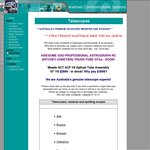With the advent of clear sky's and warmer evenings I have been researching for a affordable telescope with
a high level of magnification and light gathering performance for less than $600.
The most simple-to-use telescope that will permit outstanding stellar views at a bargain price is the Guan Sheng GS-880 10" ASDX 250mm x 1250mm Dobsonian telescope from Andrews Communications Systems for $549.
http://www.andrewscom.com.au/site-section-10.htm
Comparative online Australian prices for a 10" Dobsonian telescope are listed.
Bintel BT252-B 10" Dobsonian $629
http://www.bintel.com.au/Telescopes/Dobsonian/Bintel-BT252-B…
Australian Geographic Shop Skywatcher 10" Dobsonian Telescope $899 (delivered)
http://shop.australiangeographic.com.au/-Skywatcher-10-Dobso…
Astro Shop SkyWatcher 10-inch (254mm) with Dobsonian mount $810
http://www.myastroshop.com.au/products/details.asp?id=MAS-04…
Ozscopes.com SkyWatcher 10" Dobsonian Telescope SW880 $979.95
http://www.ozscopes.com.au/skywatcher-dobsonian-telescope-10…
A Dobsonian telescope is the essence of simplicity and a perfect choice for the astronomer who shuns hi-tech gadgetry and electronics. The "Dob" is the telescope for the deep-sky purist who wants to see the faintest objects at millions of light years beyond our solar system. The secret of the Dobsonian telescope is in its size - it is the largest telescope for the money you can buy. This ten inch Dobsonian telescope will cost less than a fancy computerized telescope half its size and will easily take you to places in the universe no smaller telescope can go. Even a advanced amateur will not outgrow a ten inch Dobsonian in his or her lifetime.
Disadvantages: Dobsonian telescopes above ten inches in size are a problem to transport - a disassembled ten inch Dobsonian telescope will still squeeze into a hatchback with all seats folded down and no passengers, but a twelve inch Dobsonian will not. Because a Dobsonian mount is all manual, it requires constant readjusting (though easily done with practice) to keep an object in the telescope eyepiece. For the same reason, it is limited for use as an astrophotography telescope.


sounds like 10 inch is the optimum size to have, as you can still fit it in a car